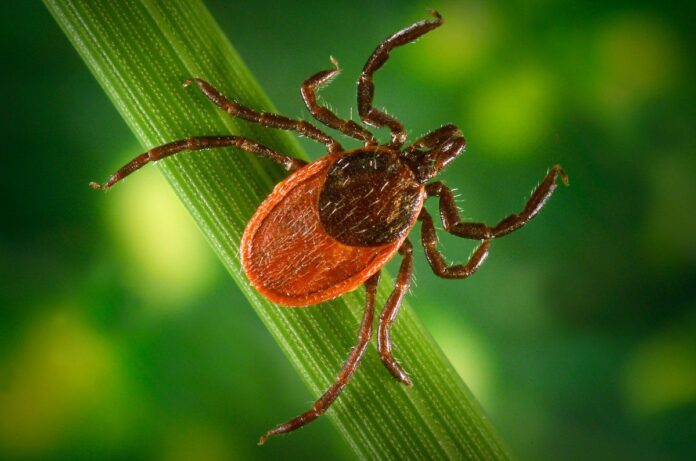Harrisburg, Pa. — Pennsylvanians experiencing “spring fever,” that perennial urge to venture outdoors to hike, hunt, fish and explore, should plan now to protect themselves and their families against potentially serious tickborne diseases — including Lyme disease and the rare but dangerous deer tick virus, which has been found in ticks at high levels for the first time in multiple locations around the state.
The Pennsylvania Department of Environmental Protection’s Tick Surveillance and Testing Program has detected unusually high infection rates of the dangerous and rare deer tick virus in adult tick samples recently taken from three sites: Fisherman’s Paradise public fishing area on Spring Creek in Centre County; Iroquois Trail near Tunkhannock in Wyoming County; and Lawrence Township Recreational Park in Clearfield County. At each of these three locations, the infection rate exceeded 80% of ticks sampled.
Deer tick virus has been detected in a total of 15 Pennsylvania counties, and the statewide infection rate outside of the three “hotspot” locations is currently 0.6% of ticks sampled.
Blacklegged ticks, also called deer ticks, are active even in winter when temperatures are in the mid-30s and above. DEP has posted signage to alert the public and will conduct control measures and additional testing to reduce and monitor the number of ticks present in the recreational areas with high positivity rates for DTV.
Precautions
Recommended precautions for anyone venturing outdoors include the following:
– Apply tick repellents containing permethrin to clothing and EPA-registered insect repellents such as DEET to exposed skin before entering the outdoors. Reapply as needed according to product label instructions.
– Wear light-colored outer clothing and tuck shirts into pants, and pants into socks.
– Walk in the centers of trails, and avoid wooded and brushy areas with low-growing vegetation and tall grasses that may harbor ticks.
– After returning home, remove all clothing, take a shower and place clothing into the dryer on high heat to kill any lingering ticks. Examine gear such as backpacks for ticks.
– Conduct a full-body tick check using a hand or full-length mirror, including hidden areas such as the scalp, ears, armpits, belly button, and between the legs.
– Check over any pets exposed to likely tick habitats each time they return indoors.
– If a tick is found attached to your skin, use tweezers to remove it carefully, including the head. Monitor for symptoms and contact your doctor with any questions.
For more information about tickborne disease prevention, visit DOH’s tickborne diseases website.
Tick surveillance
The DTV-positive ticks were discovered during routine testing as part of DEP’s active tick surveillance program, a five-year pilot program that began in 2018.
Surveys are conducted in every county in Pennsylvania to track ticks’ habitats, life stages and peak activity levels and to test them for human pathogenic diseases. Fall and winter surveillance focuses on analyzing adult blacklegged ticks for emerging and changing disease burdens in public use habitats across Pennsylvania, such as parks, playgrounds, recreational fields and state game lands.
The previous highest DTV infection rate found at a single location in Pennsylvania was 11%, and the highest infection rate reported nationally in scientific literature was approximately 25%. The statewide average infection rate for DTV was 0.6% in 2021 when adult tick samples were collected.
The deer tick virus, which is a type of Powassan virus, is rare in the United States, but positive cases have increased in recent years. It is spread to people primarily by bites from infected ticks and does not spread person-to-person through coughing, sneezing, or touching.
Powassan virus
Powassan virus can be transmitted from tick to human in as little as 15 minutes after a bite occurs, while other tickborne diseases, such as Lyme disease, take much longer to cause infection, often 24 hours or more after the tick attaches to the host.
There are no vaccines to prevent or medicines to treat Powassan viruses. Preventing tick bites is the best way to reduce risk of infection and disease. Initial symptoms of a DTV infection may include fever, headache, vomiting and weakness. Some people who are infected with DTV experience no symptoms, and therefore infection may go undetected. However, 91% of patients treated for DTV infections develop severe neuroinvasive disease.
Those who exhibit severe disease from deer tick virus may experience encephalitis or meningitis and require hospitalization, with symptoms including confusion, loss of coordination, difficulty speaking or seizures. About 12% of people with severe disease have died, and approximately half of survivors of severe disease have suffered long-term health impacts.
For more information about the health impacts of DTV, visit the CDC Powassan Virus website.










